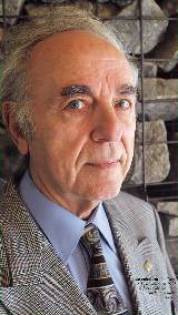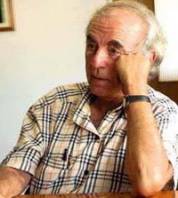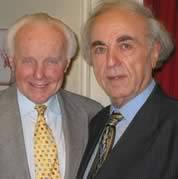This celebration of 31 stories about men and women who risked crossing religious boundaries to help heal the world began on January 1 with a story about John Paul II. To read more about this online celebration and the companion book — read our story about it.

HERE IS THE 2nd OF OUR 31 STORIES THIS YEAR:
BARUCH TENEMBAUM (B. 1933)
”THE AGREEMENT is based on respect, the knowledge and understanding of our rights that each one of us can be different from the other.”
Baruch Tenembaum was born in Santa Fe, Argentina, a settlement for Jewish immigrants fleeing the violence of Russian pogroms in the late 19th Century. A son of Jewish-Argentine cowboys—gauchos—he entered academia, teaching the Hebrew and Yiddish languages, Yiddish literature, the Hebrew Scriptures and philosophy. He also became a businessman, establishing the Israeli Tourist Office in Buenos Aires.
A central passion to Tenembaum’s life has been Jewish-Christian relationships, particularly relationships between Jews and the Catholic Church. He used his position as a travel agent to organize a group of Argentine Catholic priests to visit the Holy Land. Out of that trip, working with his friends among Catholic clergy and other businesspeople, Tenembaum helped establish the Casa Argentina en Jerusalem that hosted opportunities for Catholics and Jews to get together and learn from each other. Tenembaum then decided to move from working with the priests to inviting the pope to visit Israel.
During a visit to the Vatican in 1965, Tanembaum personally invited Pope Paul VI to visit Jerusalem, which resulted in the first such visit to that holy city by a pope.

Tenembaum promoted the idea of establishing interfaith monuments. His first major project was the commissioning of a fresco by the Argentine painter Raul Soldi in the main church in Nazareth, which was finished in 1968 and has been seen by more than 10 million people. He also organized the production of a memorial mural dedicated to victims of the Holocaust in the Buenos Aires Cathedral. In April 1997 the mural, containing Jewish religious texts, was unveiled by the Cardinal of Argentina, Antonio Quarracino, Polish Nobel Peace Prize winner Lech Walesa and Tenembaum. A replica of the mural was made in the Vatenrunser Church in Berlin.
Tenembaum’s interfaith work ended up putting his life at risk. A terrorist group associated with the Argentine military dictatorship kidnapped him in 1976. They accused him of ”infecting the Catholic Church with the virus of Judaism” and ”of spreading ideas of alleged coexistence so as to destroy Christian principles.” When his wife Perla volunteered to be a hostage, she was kidnapped as well. Eventually they were released in large part due to the mediation and advocacy efforts of a Catholic priest, Father Horacio Moreno.

Following the kidnapping, Tenembaum left Argentina for the U.S. He sought out Gentiles who had helped Jews during the Holocaust. With the help of Congressman Tom Lantos, a Holocaust survivor, he founded The International Raoul Wallenberg Foundation to promote the life and work of Raoul Wallenberg. (Lantos and Tenembaum are shown at right.)
Wallenberg was a Swedish diplomat stationed in Hungary who saved almost 100,000 Jews from deportation to the death camps. Wallenberg was seized by the Soviet Army at the end of the war, and he was never seen again. Tenembaum established the Wallenberg Foundation to fight intolerance, racism and violence and to stimulate the courage to defend the weak against aggression and violence. More than 60 heads of state and 30 Nobel Prize laureates are members of the Wallenberg Foundation. One of the stories highlighted by the foundation is that of Irena Sendler, who also appears in our new companion book, ”Interfaith Heroes 2.”
Tenembaum has continued to work on issues of interfaith dialogue and reconciliation. He sees fear as the fuel that touches off crimes of religious violence. Getting to know someone enables people to let go of their fears, about which Tenembaum said, ”This simple and basic principle is the main base of the interconfessional dialogue.”
His perspective on interfaith dialogue and relationships was not to find the lowest common denominator between faiths or to simply tolerate people who were different. He said, ”The agreement is not about faith or theological beliefs. Each of us will continue sticking to his or her faith, and his or her source of inspiration. The agreement is based on respect, the knowledge and understanding of our rights that each one of us can be different from the other.”
CARE TO READ MORE?
Visit the Founder’s page at the International Raoul Wallenberg Foundation. There you’ll find more about Tenembaum’s work, including an overview of the U.S. Congress’ honors for Tenembaum’s humanitarian accomplishments.
Or, visit Tenembaum’s own Web page, which is available in both English and Spanish.
”Interfaith Heroes 2” (cover at right) will be available soon from Amazon and other online retailers, containing this story honoring Tenembaum and dozens of other interfaith heroes.
PLEASE, Tell us what you think by leaving a Comment.
Not only do we welcome your notes, ideas, suggestions and personal reflections—but our readers enjoy them as well. Your short Comment may make someone else’s day.
(Originally published at http://www.ReadTheSpirit.com/)

